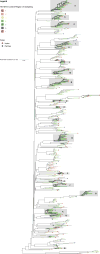Leveraging Phylogenetics to Understand HIV Transmission and Partner Notification Networks
- PMID: 29940601
- PMCID: PMC6058319
- DOI: 10.1097/QAI.0000000000001695
Leveraging Phylogenetics to Understand HIV Transmission and Partner Notification Networks
Abstract
Background: Partner notification is an important component of public health test and treat interventions. To enhance this essential function, we assessed the potential for molecular methods to supplement routine partner notification and corroborate HIV networks.
Methods: All persons diagnosed with HIV infection in Wake County, NC, during 2012-2013 and their disclosed sexual partners were included in a sexual network. A data set containing HIV-1 pol sequences collected in NC during 1997-2014 from 15,246 persons was matched to HIV-positive persons in the network and used to identify putative transmission clusters. Both networks were compared.
Results: The partner notification network comprised 280 index cases and 383 sexual partners and high-risk social contacts (n = 131 HIV-positive). Of the 411 HIV-positive persons in the partner notification network, 181 (44%) did not match to a HIV sequence, 61 (15%) had sequences but were not identified in a transmission cluster, and 169 (41%) were identified in a transmission cluster. More than half (59%) of transmission clusters bridged sexual network partnerships that were not recognized in the partner notification; most of these clusters were dominated by men who have sex with men.
Conclusions: Partner notification and HIV sequence analysis provide complementary representations of the existent partnerships underlying the HIV transmission network. The partner notification network components were bridged by transmission clusters, particularly among components dominated by men who have sex with men. Supplementing the partner notification network with phylogenetic data highlighted avenues for intervention.
Conflict of interest statement
Figures


Similar articles
-
Molecular Analysis of Human Immunodeficiency Virus Type 1 (HIV-1)-Infected Individuals in a Network-Based Intervention (Transmission Reduction Intervention Project): Phylogenetics Identify HIV-1-Infected Individuals With Social Links.J Infect Dis. 2018 Jul 24;218(5):707-715. doi: 10.1093/infdis/jiy239. J Infect Dis. 2018. PMID: 29697829 Free PMC article.
-
Phylogenetic Investigation of a Statewide HIV-1 Epidemic Reveals Ongoing and Active Transmission Networks Among Men Who Have Sex With Men.J Acquir Immune Defic Syndr. 2015 Dec 1;70(4):428-35. doi: 10.1097/QAI.0000000000000786. J Acquir Immune Defic Syndr. 2015. PMID: 26258569 Free PMC article.
-
Human Immunodeficiency Virus (HIV)-1 Transmission Among Persons With Acute HIV-1 Infection in Malawi: Demographic, Behavioral, and Phylogenetic Relationships.Clin Infect Dis. 2019 Aug 16;69(5):853-860. doi: 10.1093/cid/ciy1006. Clin Infect Dis. 2019. PMID: 30476007 Free PMC article. Clinical Trial.
-
Partner notification for HIV prevention: a critical reexamination.AIDS Educ Prev. 1997 Jun;9(3 Suppl):68-78. AIDS Educ Prev. 1997. PMID: 9241399 Review.
-
When it comes to contact notification, HIV is not TB.Int J Tuberc Lung Dis. 2003 Dec;7(12 Suppl 3):S337-41. Int J Tuberc Lung Dis. 2003. PMID: 14677819 Review.
Cited by
-
An Enhanced Social Network Strategy to Increase the Uptake of HIV Services: Protocol for Type I Hybrid Implementation Study (Carolinas RESPOND).JMIR Public Health Surveill. 2025 Aug 29;11:e69495. doi: 10.2196/69495. JMIR Public Health Surveill. 2025. PMID: 40882210 Free PMC article.
-
Prevalence and Transmission Dynamics of HIV-1 Transmitted Drug Resistance in a Southeastern Cohort.Open Forum Infect Dis. 2018 Jul 20;5(8):ofy178. doi: 10.1093/ofid/ofy178. eCollection 2018 Aug. Open Forum Infect Dis. 2018. PMID: 30151407 Free PMC article.
-
Evaluation of Phylogenetic Methods for Inferring the Direction of Human Immunodeficiency Virus (HIV) Transmission: HIV Prevention Trials Network (HPTN) 052.Clin Infect Dis. 2021 Jan 23;72(1):30-37. doi: 10.1093/cid/ciz1247. Clin Infect Dis. 2021. PMID: 31922537 Free PMC article.
-
Priority Intervention Targets Identified Using an In-Depth Sampling HIV Molecular Network in a Non-Subtype B Epidemics Area.Front Cell Infect Microbiol. 2021 Mar 29;11:642903. doi: 10.3389/fcimb.2021.642903. eCollection 2021. Front Cell Infect Microbiol. 2021. PMID: 33854982 Free PMC article.
-
Phylodynamic Analysis Complements Partner Services by Identifying Acute and Unreported HIV Transmission.Viruses. 2020 Jan 27;12(2):145. doi: 10.3390/v12020145. Viruses. 2020. PMID: 32012700 Free PMC article.
References
-
- National Center for HIV/AIDS VH, STD, and TB Preventio. HIV in the Southern United States. Atlanta, GA: Centers for Disease Control and Prevention; May, 2016. 2016.
Publication types
MeSH terms
Grants and funding
LinkOut - more resources
Full Text Sources
Other Literature Sources
Medical

